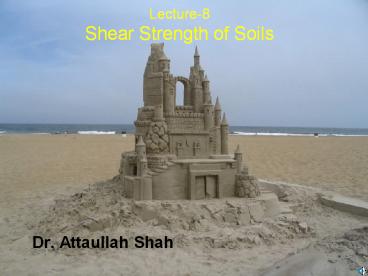Lecture-8 Shear Strength of Soils - PowerPoint PPT Presentation
Title:
Lecture-8 Shear Strength of Soils
Description:
Lecture-8 Shear Strength of Soils Dr. Attaullah Shah Shear failure Soils generally fail in shear Shear failure Shear failure mechanism Shear failure of soils Soils ... – PowerPoint PPT presentation
Number of Views:5555
Avg rating:3.0/5.0
Title: Lecture-8 Shear Strength of Soils
1
Lecture-8 Shear Strength of Soils
- Dr. Attaullah Shah
2
Strength of different materials
3
What is Shear Strength?
- Shear strength in soils is the resistance to
movement between particles due to physical bonds
from - Particle interlocking
- Atoms sharing electrons at surface contact points
- Chemical bonds (cementation) such as crystallized
calcium carbonate
4
Influencing Factors on Shear Strength
- The shearing strength, is affected by
- soil composition mineralogy, grain size and
grain size distribution, shape of particles, pore
fluid type and content, ions on grain and in pore
fluid. - Initial state State can be describe by terms
such as loose, dense, over-consolidated,
normally consolidated, stiff, soft, etc. - Structure Refers to the arrangement of particles
within the soil mass the manner in which the
particles are packed or distributed. Features
such as layers, voids, pockets, cementation, etc,
are part of the structure.
5
Shear Strength of Soil
- In reality, a complete shear strength formulation
would account for all previously stated factors. - Soil behavior is quite complex due to the
possible variables stated. - Laboratory tests commonly used
- Direct Shear Test
- Unconfined Compression Testing.
6
Soil Failure and shear strength.
- Soil failure usually occurs in the form of
shearing along internal surface within the
soil. - Thus, structural strength is primarily a function
of shear strength. - Shear strength is a soils ability to resist
sliding along internal surfaces within the soil
mass.
7
Slope Stability Failure is an Example of
Shearing Along Internal Surface
8
Mass Wasting Shear Failure
9
Shear Failure Earth Dam
10
Shear Failure Under Foundation Load
11
Shear failure
- Soils generally fail in shear
embankment
strip footing
At failure, shear stress along the failure
surface reaches the shear strength.
12
Shear failure
The soil grains slide over each other along the
failure surface.
No crushing of individual grains.
13
Shear failure mechanism
At failure, shear stress along the failure
surface (?) reaches the shear strength (?f).
14
Shear failure of soils
- Soils generally fail in shear
15
Shear failure of soils
- Soils generally fail in shear
Retaining wall
At failure, shear stress along the failure
surface (mobilized shear resistance) reaches the
shear strength.
16
Mohr-Coulomb Failure Criterion
?
?
failure envelope
friction angle
cohesion
c
?
?f is the maximum shear stress the soil can take
without failure, under normal stress of ?.
17
Mohr-Coulomb Failure Criterion(in terms of total
stresses)
?
?f is the maximum shear stress the soil can take
without failure, under normal stress of ?.
18
Mohr-Coulomb Failure Criterion(in terms of
effective stresses)
u pore water pressure
?f is the maximum shear stress the soil can take
without failure, under normal effective stress of
?.
19
Mohr-Coulomb Failure Criterion
Shear strength consists of two components
cohesive and frictional.
20
Mohr-Coulomb Failure Criterion
Shear strength consists of two components
cohesive and frictional.
c and ? are measures of shear strength.
Higher the values, higher the shear strength.
21
(No Transcript)
22
(No Transcript)
23
(No Transcript)
24
Determination of shear strength parameters of
soils (c, f or c, f)
Other laboratory tests include, Direct simple
shear test, torsional ring shear test, plane
strain triaxial test, laboratory vane shear test,
laboratory fall cone test
25
Laboratory tests
Field conditions
26
Laboratory tests
Simulating field conditions in the laboratory
Step 2 Apply the corresponding field stress
conditions
27
Direct shear test
Schematic diagram of the direct shear apparatus
28
Direct shear test
Direct shear test is most suitable for
consolidated drained tests specially on granular
soils (e.g. sand) or stiff clays
Preparation of a sand specimen
29
Direct shear test
Preparation of a sand specimen
30
Direct shear test
Test procedure
31
Direct shear test
Step 2 Lower box is subjected to a horizontal
displacement at a constant rate
32
Direct shear test
33
Direct shear test
Analysis of test results
Note Cross-sectional area of the sample changes
with the horizontal displacement
34
Direct shear tests on sands
Stress-strain relationship
35
Direct shear tests on sands
How to determine strength parameters c and f
36
Direct shear tests on sands
Direct shear tests are drained and pore water
pressures are dissipated, hence u 0
Sand is cohesionless hence c 0
Therefore, f f and c c 0
37
Direct shear tests on clays
In case of clay, horizontal displacement should
be applied at a very slow rate to allow
dissipation of pore water pressure (therefore,
one test would take several days to finish)
Failure envelopes for clay from drained direct
shear tests
38
Interface tests on direct shear apparatus
In many foundation design problems and retaining
wall problems, it is required to determine the
angle of internal friction between soil and the
structural material (concrete, steel or wood)
39
Triaxial Shear Test
40
Triaxial Shear Test
Specimen preparation (undisturbed sample)
41
Triaxial Shear Test
Specimen preparation (undisturbed sample)
42
Triaxial Shear Test
Specimen preparation (undisturbed sample)
43
Triaxial Shear Test
Specimen preparation (undisturbed sample)
44
Unconfined Compression Test (UC Test)
s1 sVC Ds
s3 0
Confining pressure is zero in the UC test
45
Unconfined Compression Test (UC Test)
tf s1/2 qu/2 cu
46
THE END
47
- The End






























